
This guide walks you through the technical and functional features that truly matter when evaluating loyalty software – so you can choose a provider that empowers both your marketing and dev teams.
Loyalty management software is a platform or system designed to help brands build, launch, and manage customer loyalty programs. It allows marketing and product teams to automate reward workflows, track customer engagement, and personalize incentives at scale.
Unlike rigid, in-house loyalty tools, modern out-of-the-box loyalty software offers faster implementation, lower dev overhead, and greater flexibility. Businesses can create tiered programs, issue loyalty points, send referral rewards, or run gamified promotions – all with minimal engineering effort.
A loyalty platform like Voucherify listens to customer actions in real time – such as purchases, signups, or referrals – and processes them through API-based workflows to validate eligibility, assign rewards, and trigger personalized notifications.
Learn more: 25 Best Loyalty Management Software [With Pros and Cons]
Selecting the right loyalty program software isn’t something to squeeze in between meetings. If your goal is to build a scalable, flexible loyalty system, you need to go beyond the surface and evaluate how each platform actually fits into your tech stack.
Start by defining what your loyalty program needs to accomplish, which reward mechanics you want to enable, and what kind of customer data will drive it. If you’re building for growth, avoid platforms that just track points. Instead, look for API-first loyalty platforms that support complex logic – like event-based rewards, tier upgrades, referral tracking, and usage-based incentives.
Also consider how easily the platform integrates with your current systems:
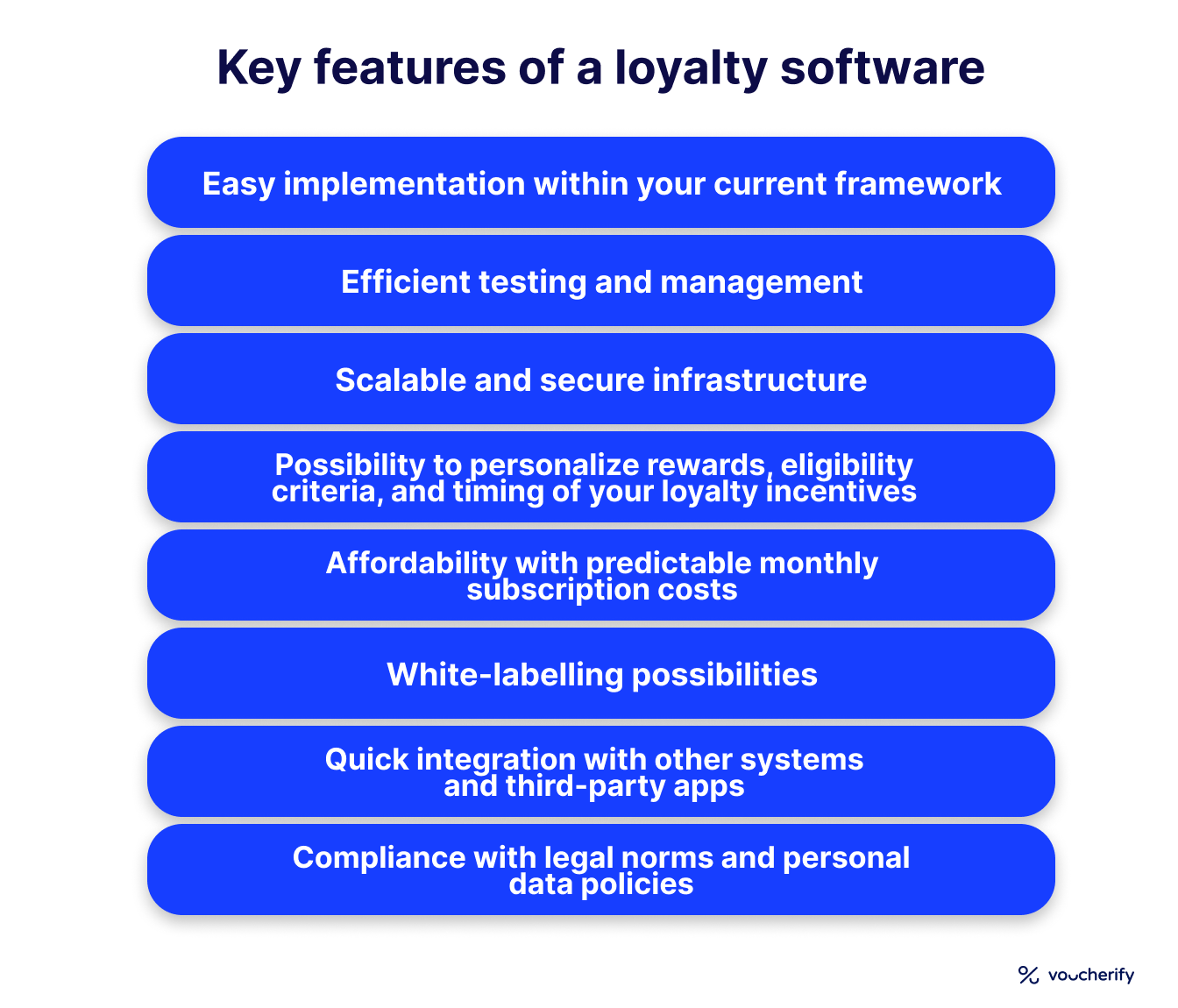
Platforms offering these out-of-the-box capabilities have driven real results. For instance, brands using Voucherify have seen:
Such gains are tied directly to API-first infrastructure, real-time orchestration, and granular reward logic.
Now that we've covered the core capabilities every loyalty solution should offer out of the box, let’s dive deeper into the advanced features that truly set a modern loyalty platform apart.
To make this easier to navigate, I’ve divided the feature list into two categories:
To connect your campaigns with customer attributes, you need to make your customer loyalty program management system aware of them. This means that you need to sync it with your CRM and CDP software, such as Braze, Segment, or mParticle. The best reward program management software should be capable of storing every data relevant to your offered incentives.
A global fashion retailer integrates its loyalty platform with, for example, Segment and Braze to sync real-time behavioral traits (e.g. session abandonment, promo engagement) across countries. Based on synced CDP traits (like lifecycle stage or loyalty tier), customers in France receive referral-based incentives, while users in the US get spend-based ones – all orchestrated through CDP flows that call a promotion engine to trigger reward campaigns.
Learn more: How integrating with a CDP doubles customer loyalty?
Dynamic segmentation adds your customers to the relevant segment based on their data. This means every customer that meets the requirements will be assigned to the appropriate segment and access the relevant campaigns.
Dynamic segmentation helps marketers target specific customer segments in real-time, saving them time on doing the segmentation manually. With the advanced set of filters, marketers can split the customer base into fine-grained groups like “dormant,” “offer X product,” “anniversary” and so on.
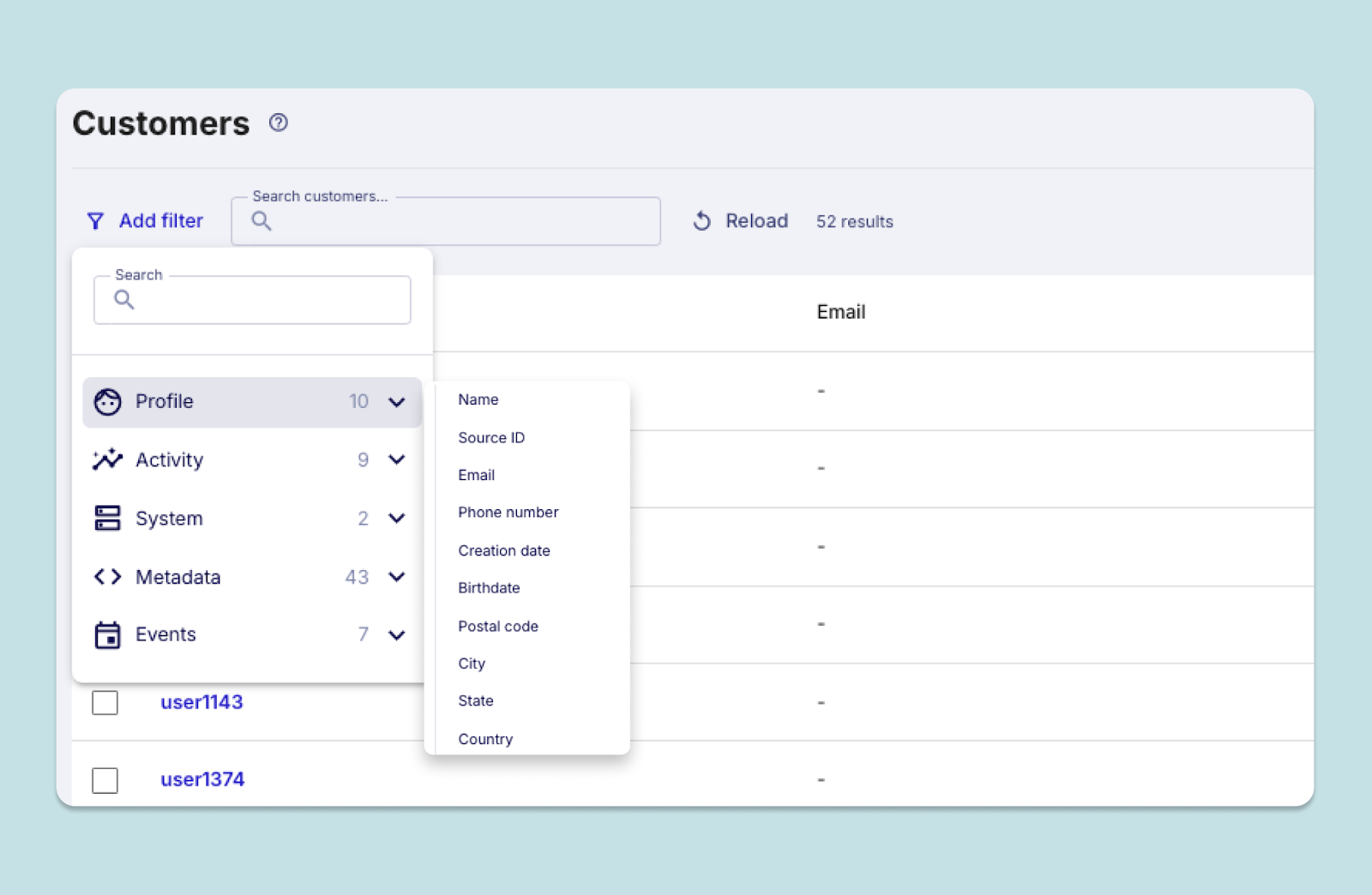
Here’s a simplified JSON example of a segment based on country and lifetime spend:
{
"segment": "high-spenders-DE",
"criteria": {
"metadata.country": "DE",
"total_spent": { "$gt": 2000 }
}
}Segments are built dynamically on SKU category and basket mix. For example, “Plant-based weekday shoppers” are those who buy 3+ vegetarian SKUs from Mon–Thur in 2 consecutive weeks. When this segment updates, users are automatically enrolled into a recurring challenge campaign to earn $10 off if they maintain the pattern for a third week.
Your customer loyalty program management system should support the following reward types:
Needless to say, these parameters should be easy to tweak from the UI, so that marketers don’t have to bother the development team every time they want to modify anything in the loyalty program.
The game studio offers time-bound points multipliers during tournaments. Points are issued for completing in-game quests, which are logged as custom events. A modular reward catalog maps event IDs to different point values – e.g. “boss_defeated_final” → 300 pts, “daily_check_in” → 10 pts. Rewards like loot boxes, tokens, or early access are unlocked via cart-like reward redemptions.
Learn more: 20+ ideas for creative loyalty rewards
Good customer loyalty software lets you set up fine-grained validation rules. It is not enough to set the rules and hard-code them once. You should be able to change them as you learn more about your customers and special promotions.
In general, you should be able to set the validation rules based on:
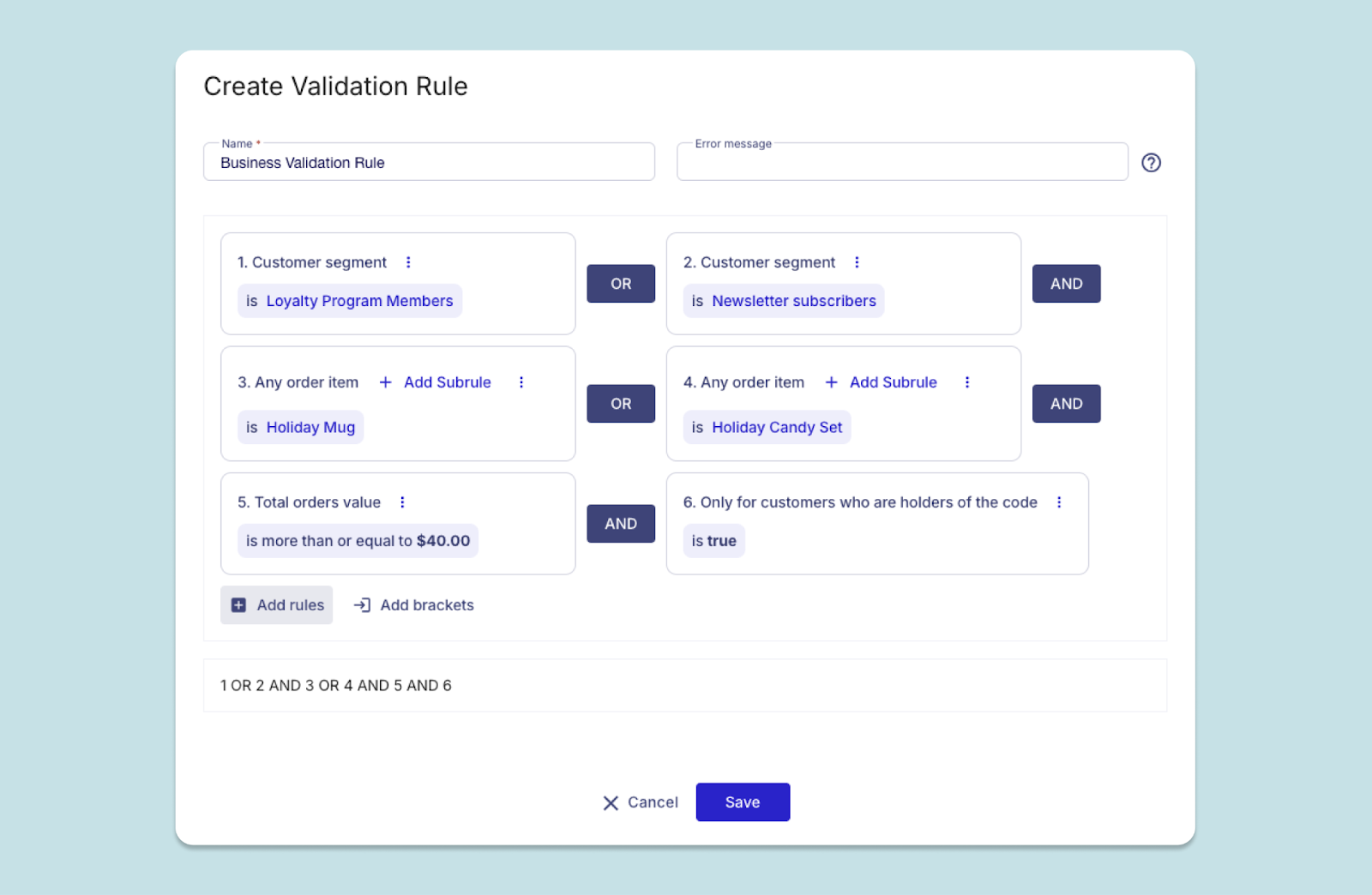
A “Double Points for Summer Trips” campaign applies only to bookings above $1,000 for flights leaving between June 15–August 31, booked in the mobile app by loyalty members who booked at least once in the last 6 months. All these conditions are validated using dynamic rules triggered by a custom event (booking.created) and fed to the API in real time.
Creating loyalty tiers (levels) can help make your customer loyalty program more interesting for the customers, adding a gamification effect. Customers could be qualified to various loyalty levels based on their purchases or custom events.
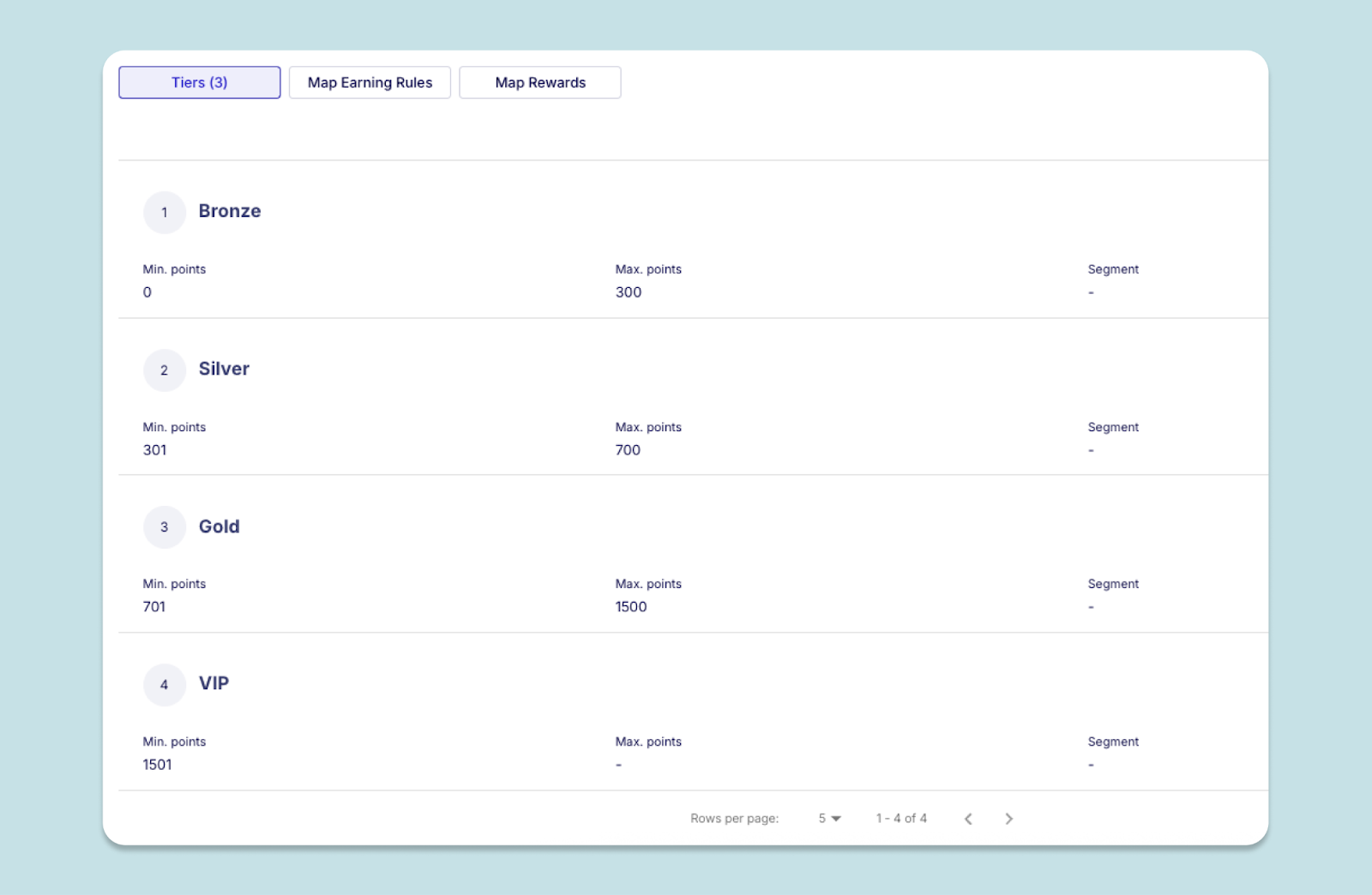
The levels could differ by:
To make tier-based rewards actionable, here’s an example of assigning a reward to a loyalty card holder after they qualify for a VIP tier, using the Voucherify SDK:
const client = require('@voucherify/sdk')({
applicationId: 'APP_ID',
applicationToken: 'APP_TOKEN'});
// Reward assignment logic
await client.loyalties.createRewardAssignments(campaignId, {
beneficiary: { loyalty_id: "member_456" },
reward_id: "reward_vip_upgrade"
});Customers level up based on cumulative session attendance and in-app actions like joining a live class. Each tier unlocks new classes, early access to partner discounts (sent via webhooks), and increased point multipliers. Logic for upgrade/downgrade is decoupled from UI – handled via metadata in the loyalty engine and syncs to mobile clients via SDK.
Learn more: How to increase the engagement in your loyalty campaign with tiers?
The loyalty rewards stacking feature defines allowed and forbidden discount combinations that give you even more space for personalization.
For instance, you can offer two types of loyalty rewards: discounts and gift card credits, and disallow using both for the same order. You should be also able to define which loyalty rewards should or shouldn't be combined with other promotions.
To maintain profitability, the business allows cashback + free shipping to stack, but disallows use of both alongside discount codes. During checkout, the loyalty management system validates stacking logic using a pre-redeem API call. If the payload includes multiple reward types, the platform checks a matrix of exclusion rules before finalizing redemption eligibility.
Learn more: What is discount and reward stacking?
An omnichannel approach to loyalty campaigns isn’t an option anymore – it’s a must. We can talk here about in-app messages, dedicated landing pages, Google & Meta ads, web channels, or SMS. You probably already use some 3rd party communication providers to activate these channels, so your loyalty program software should be easily integrated with them through a plugin, Zapier integration, or API.
The right loyalty platform should automatically trigger webhooks when loyalty events happen – like when a customer earns points. Here’s a sample payload sent by Voucherify when points are added:
{
"id": "whs_0e16e42bc6e0c65b57",
"project_id": "proj_5T4Rpl4T1nuM",
"created_at": "2025-07-31T10:22:33.123Z",
"type": "voucher.loyalty_card.points_added",
"data": {
"customer": {
"id": "cust_123",
"source_id": "external_789"
},
"points": 150,
"campaign": {
"id": "camp_987",
"name": "Summer2025" }
}
}Apart from development efforts, running reward programs requires operational help from customer agents. Somebody has to answer dozens of customer questions related to terms of conditions and rewards. To reduce the load of this task, your rewards system should provide customers with an easy way to monitor their performance and redeem rewards.
Customer portal, or a digital wallet, integrated with your online shop or app, where the customers see their progress and previous rewards, is a smart solution. Because there’s a high chance people will be visiting it often, marketers can use this space to advertise other, relevant offers.
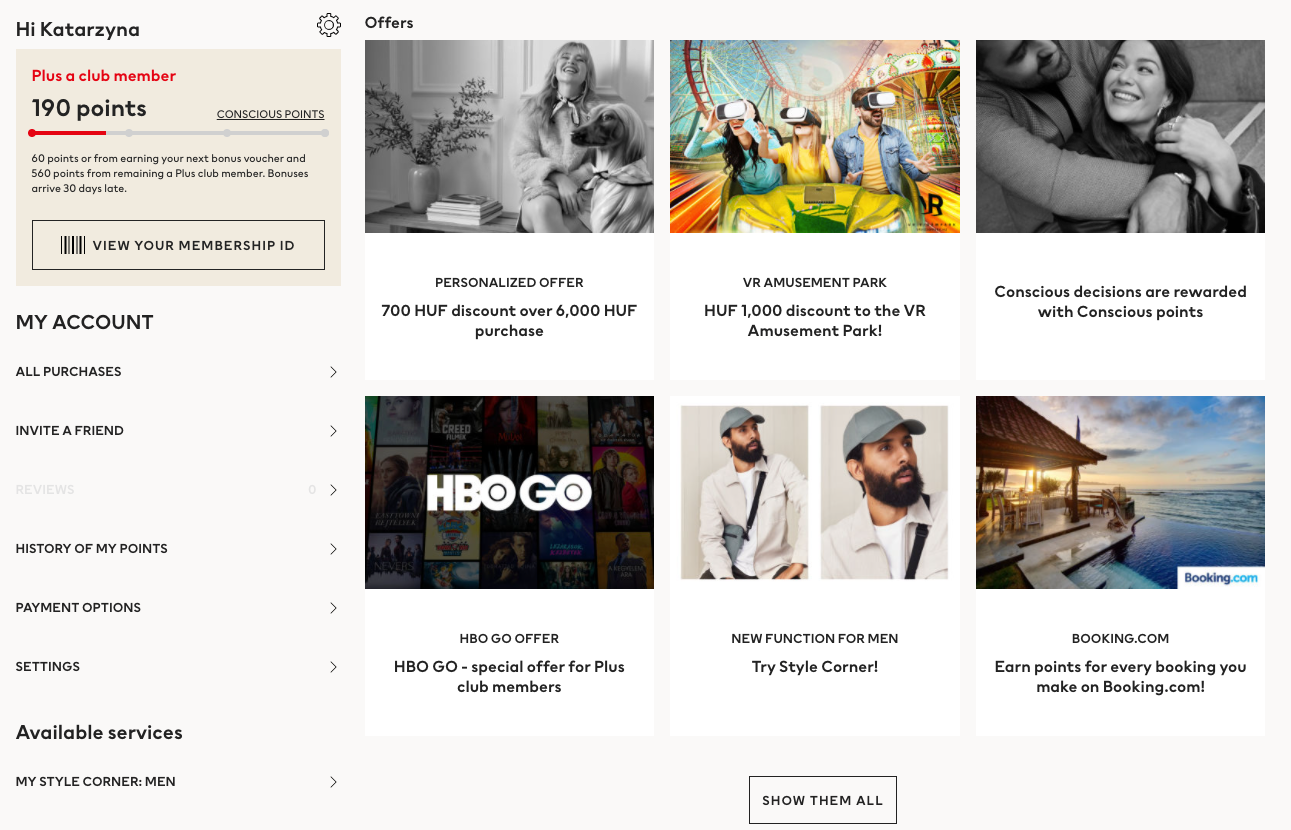
A great feature of an excellent customer loyalty program is reminders. To cut through the noise and avoid being accused of spamming your customers, you should send relevant and informational notifications about your reward program details or their progress.
Smart reminders are based on real-time customer attributes and are timely displayed non-intrusively on a device of choice. You should notify loyalty members about:
A customer completes five rides within seven days. After the fifth ride, they receive a personalized promo code for their next trip, sent 15 minutes after the ride. If the promo goes unused for three days, the customer gets a reminder through the app. Such a setup uses ride data and customer activity to deliver timely and relevant messages.
You should be able to run multiple A/B tests and iterations to try out different variations of your rewards program before the launch. You need to remember that every marketing campaign is an experiment. It starts with a hypothesis, goes through a small-scale test in the field, and ends up with a global launch.
That’s why you need a tool that allows for multiple tests to see what incentives and what kind of workflow has the biggest chance of success for your particular audience. Iterations are made possible by detailed monitoring and tracking tools that should be transparent and readable for both marketers and developers.
Invest in a loyalty program software that allows you to personalize your incentives quickly. What makes a good personalization? When talking about customer loyalty programs, personalization should cover three areas: rewards, eligibility, and timing.
Customers who view high-end skincare products more than 3 times in 7 days are eligible for personalized sample boxes. A backend function monitors event streams and assigns personalized coupons tied to customer preferences – all rules adjustable via API or UI, depending on campaign phase.
Learn more: What makes good personalization?
Your loyalty program should have offline redemptions enabled. This could be solved via a loyalty app or QR codes, for example. You could also use Google Pay integration, if the loyalty platform has native integration with it, to connect your rewards program with the Google Pay app to allow offline redemptions.
Season ticket holders redeem snack coupons in-venue by scanning a QR code at POS terminals. The redemption hits the loyalty system in real time, deducting points and updating the user’s progress toward merchandise rewards. If offline, the QR encodes a signed token verified at the POS layer.
When it comes to loyalty program software, you should look for a holistic solution that goes the extra mile and allows you to do more. Invest in software that can act as your CRM database, messaging hub, and command center for other incentives like discount vouchers, referral programs, or even online giveaways.
Paying for only one feature is merely wasteful. You’d be much better off with high-quality customer loyalty software that you can use to go beyond the standard loyalty model. Choose more holistic solutions that let you shape inspiring incentives that will always surprise and delight your audience.
The beginnings are always the hardest, but in the context of a loyalty program, the opposite is usually true. The launch is the easiest part, followed by a tidal wave of requests, questions, inevitable complaints, and support tickets. Manual redemption and addition of points or withdrawal of a batch of coupons or points is yet another pain in the neck for your customer support agents.
There are several features of good customer loyalty program that can help you to shoulder the burden:
During peak events like Singles’ Day, the loyalty API scales to handle 10,000+ redemptions per minute. Admins use logs to resolve disputes (e.g. missed points), and CS teams can manually override or bulk-apply rewards via an admin panel – no engineering escalation needed.
If you lack the legal know-how, seek the advice of a professional legal advisor as loyalty programs tend to be like a can of worms. But, there are several legal provisions that all good loyalty software should meet. First of all, it should allow you to create clear and concise terms and conditions for your incentive.
Another significant issue is data privacy, primarily if you operate in the GDPR or CAN-SPAM applicable region. Opt for loyalty software that allows you to handle customer data in a transparent way. Also, go for a loyalty provider that lets you create and manage marketing permissions and opt-in consents. Otherwise, you can expect a big chunk of your messages to go straight to the spam folder.
All opt-in/opt-out events are stored with timestamps and purpose codes, and pushed to the CRM. Legal teams can export granular consent logs per customer or campaign, and automated flags ensure no reward messaging goes out to unconsented users, based on real-time privacy states.
Learn more: What is zero-party data and how to collect it via loyalty programs?
After launching and distributing your incentives among your audience, you need to make sure that your loyalty program is safe. That’s why you need to consider whether the loyalty provider of your choice offers built-in anti-fraud loyalty measures. Look for easy marketing permissions management, email anti-fraud options, or double-opt-in verification to confirm the identity of your program participant.
Another option worth looking into is the loyalty points rolling expiration that ensures that customers have X days after their last point transaction to either earn more points or use them. This feature ensures that no points and no rewards will be either collected or claimed after the end of your program.
The system flags suspicious referrals where multiple signups share the same device fingerprint, IP range, or disposable email domains. A rule engine blocks reward issuance automatically, and notifies an admin dashboard for manual review and audit logging.
If your clients are used to a particular look, style, and feel of your messages, stick to it. Just make sure that your loyalty provider allows you to use your own brand guidelines and vibe. When scanning the functionalities of different loyalty software, keep an eye out for white labeling possibilities. It would be useful to have a landing page creator, form, or e-mail editor to ship your rewards program communication materials faster and with your own branding. Keep in mind that API-first loyalty software providers make white labeling even simpler to achieve.
Each franchise location has branded customer touchpoints for emails and reward pages. A frontend theme engine maps brand tokens to UI components and all reward data is pulled from a central loyalty engine via scoped API keys tied to each franchise’s project or environment.
You want your customer loyalty program software to be like the popular kid on the block. Other software providers need to know him and get along just fine. The easiest way to ensure smooth communication between different data systems and services is the use of a flexible loyalty API. With a robust and developer-friendly API in place, you only need to integrate your e-commerce services with new loyalty software. Then you can manage the program yourself. If integration is impossible or greatly hindered, you’d better give it a wide berth and seek loyalty solutions that will quickly adapt to services that you already use and enjoy.
The API-first loyalty program software is also indispensable if you want to stay flexible with your messaging channels. Separating the backend from the front-end with the use of API allows you to add new channels and remove old ones from your loyalty strategy as you go.
Engineers use the loyalty SDK to integrate campaign logic directly into their React app. Reward triggers are tied to product usage milestones, and all redemptions, audits, and rollback flows are tested in sandbox environments before deployment via CI pipelines.
Feeling a little overwhelmed with the toolkit? I’ve got you. Let’s walk through a table presenting short, digestible pros and cons of each loyalty feature so you can pick what you really need – and skip what you don’t.
Before wrapping up, it's worth exploring the contemporary developments transforming loyalty programs today:
According to McKinsey’s, 71% of consumers expect companies to deliver personalized experiences – and 76% become frustrated when those expectations aren’t met. Meanwhile, Gartner predicts that by 2026, over 80% of enterprises will have adopted generative AI APIs or deployed generative AI‑powered applications.
AI is changing how loyalty programs adapt to users in real time:
AI personalization in loyalty platforms isn’t just about sending the right message – it’s about orchestrating intelligent, context-aware experiences that evolve with each customer. The most effective loyalty programs go beyond email campaigns or product suggestions. They tap into deep loyalty logic – such as tiers, points, milestones, and rewards – and personalize them based on behavior, lifecycle stage, or even external signals like location or timing.
A 2024 Harvard Business Review study found that 73% of customers prefer to shop across multiple channels – reinforcing why omnichannel consistency is no longer optional. Customers interact across multiple channels – your loyalty logic should easily follow all of them:
Legacy, all-in-one loyalty suites are giving way to composable, API-first architectures:
Gartner’s analysis highlights that organizations adopting composable, modular architectures deliver new capabilities up to 80% faster and greatly reduce risk of vendor lock-in – enabling quicker innovation cycles and business agility.
Learn more: Building loyalty programs in a composable architecture: A practical guide
Investing in the right customer loyalty platform can significantly boost your marketing efficiency and ROI. The best solutions are flexible, developer-friendly, and built to scale with your business.
Here’s what to keep in mind when selecting your loyalty management software:
Pro tip:
Before launching your first rewards program, align with your CTO or product team. Review your tech stack, define must-have loyalty features, and map out your customer journey. Use the checklist from this article to prioritize functionalities, then pick a provider that checks all the boxes – now and in the future.
.svg)